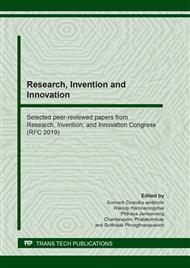[1]
S. Pervaiz, I. Deiab, A. Rashid, M. Nicolescu, Prediction of energy consumption and environmental implications for turning operation using finite element analysis, Proc. Inst. Mech. Eng. Part B: J. Eng. Manuf. 229 (2014) 1925-1932.
DOI: 10.1177/0954405414541105
Google Scholar
[2]
N. Fang, Q. Wu, A comparative study of the cutting forces in high speed machining of Ti–6Al–4V and Inconel 718 with a round cutting edge tool, J. Mater. Process. Technol. 209 (2009) 498-513.
DOI: 10.1016/j.jmatprotec.2008.10.013
Google Scholar
[3]
S. Pervaiz, I. Deiab and H. Kishawy, A finite element based energy consumptionanalysis for machining AISI 1045 carbon steelusing uncoated carbide tool, Adv. in Mater. and Proces. Technol. 2 (2016) 83-92.
DOI: 10.1080/2374068x.2016.1159033
Google Scholar
[4]
V. Vijayaraghavan, A. Garg, L. Gao, R. Vijayaraghavan, G. Lu, A finite element based data analytics approach for modeling turning process of Inconel 718 alloys. J. Clean. Prod. 137 (2016) 1619-1627.
DOI: 10.1016/j.jclepro.2016.04.010
Google Scholar
[5]
T. Ozel, M. Sima and A.K. Srivastava, Finite Element Simulation of High Speed Machining Ti–6Al–4V Alloy using Modified Material Models, Transactions of the North American Manufacturing Research Institution of SME. 38 (2010) 49-56.
Google Scholar
[6]
S. Pervaiz, I. Deiab, A. Rashid and M. Nicolescu, Prediction of energy consumption and environmental implications for turning operation using finite element analysis, Proc. Imech E Part B:. J. of Engineering Manufacture. 225(2015) 1925–(1932).
DOI: 10.1177/0954405414541105
Google Scholar
[7]
H. Yanda, J.A. Ghani, M. Rizal and C.H. Che Haron, Performance of uncoated and coated carbide tools in turning FCD 700 using FEM Simulation, Int. J. Simul. Model. 14(2015) 416-425.
DOI: 10.2507/ijsimm14(3)4.286
Google Scholar
[8]
S. Behera, Finite Element Modelling and Analysis of Hot Turning Operation. B.Tech project report, National Institute of Technology Rourkela, India, (2013).
Google Scholar
[9]
D. Umbrello, Finite element simulation of conventional and high speed machining of Ti6Al4V alloy, J. Mater. Process. 196 (2008) 79–87.
DOI: 10.1016/j.jmatprotec.2007.05.007
Google Scholar
[10]
G.R. Johnson, W. H. Cook, A constitutive model for metals subjected to large strains, high strain rates and high temperatures, Proceedings of the Seventh International Symposium on Ballistics, Hague, Netherlands, 54 (1983) 1–7.
Google Scholar
[11]
W.-S. Lee, C.-F. Lin, High-temperature deformation behaviour of Ti6Al4V alloy evaluated by high strain-rate compression tests, J. Mater. Process. Technol. 75 (1998) 127–136.
DOI: 10.1016/s0924-0136(97)00302-6
Google Scholar
[12]
I, Tanase, V. Popovici, G. Ceau and N. Predincea, Cutting edge temperature prediction using the process simulation with DEFORM 3D software package, Proceedings in Manufacturing Systems. 7 (2012) 265–268.
Google Scholar


